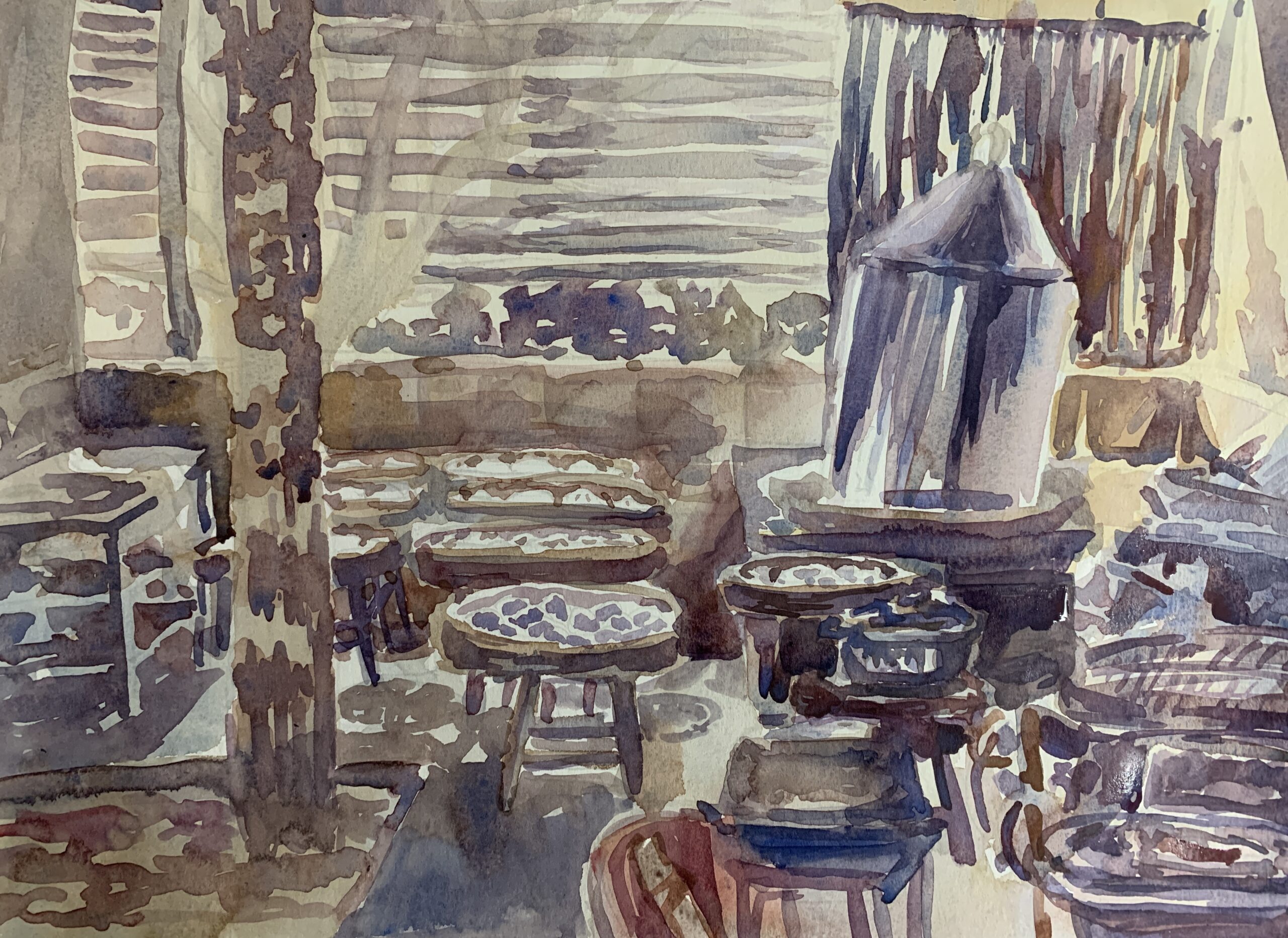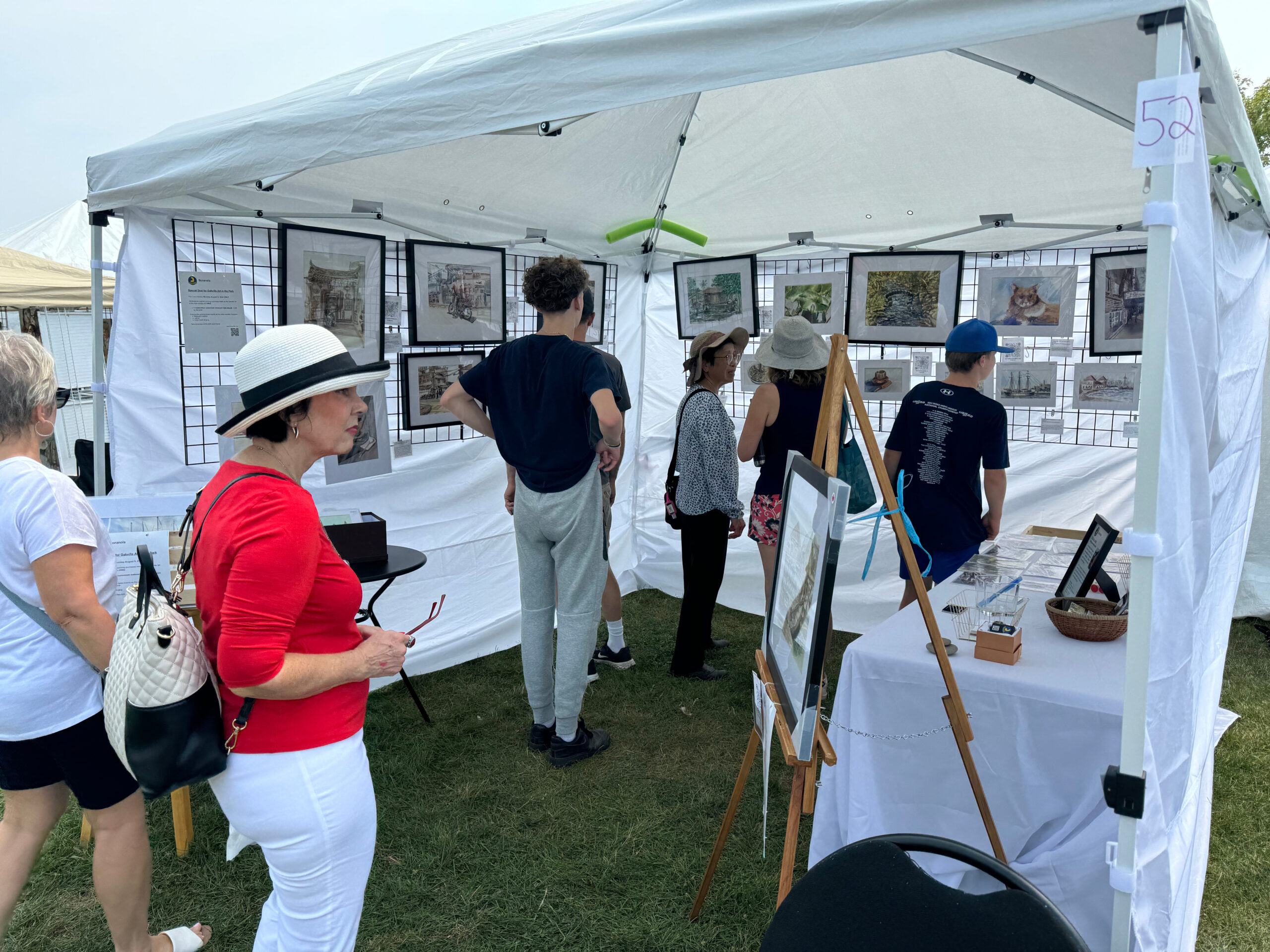I had a fantastic time at the Oakville Art in the Park on August 5, 2024. While the morning was cloudy and rain threatened, the day became hot and humid by the time patrons came by at 10 AM. It was only until about 4 PM right when the day was closing out when finally it began pouring rain in bursts.
The Dutch have a saying that there’s no such thing as bad weather, there’s just bad clothes for the season. While we of course try to predict whether it will rain, it’s a fool’s errand, as the only thing you can do is prepare for the rain and bring the items that will help. The day before, I wanted to verify I had everything down and watched a great video by Krystle Cole about rainy outdoor art festivals.
As it turned out, I was pretty well prepared but learned some things since it was my second outdoor art show and first one that rained. Last year I shared tips on doing your first outdoor art exhibit. For this new rain situation, here’s what worked and what I would improve:

- Your art will be ok in plastic containers. I used only plastic containers so everything was waterproof on the bottom. As one of my boxes had large frames, I did not bring a lid for that and had to cover it with a plastic bag. I would highly recommend getting boxes large enough so that even your largest frames can be completely sealed off.
- Bringing tarps/cardboard to put on the ground really does help. As I had thought it was going to rain in the morning before my arrival, I brought a cardboard box in case the ground was moist. This would have helped even if it was covered in morning dew. It turned out it was not necessary but it was great to have there so my other items did not have to touch the ground.
- Mentally think through what you will set up first. I packed a Toyota Corolla with all my items, and brought no more and no less than what I would show. The highest priority and first things that should touch the grass are the tables. This is so that you have a place to put the items. My tent was at the bottom of all the stuff in the car, so I had to pull out the other items before the tent. Ideally, one would put the tent at the top as one of the last things to pull out. I might rethink my stacking of items next time as a small improvement.
- Check your tent roof for holes. So my tent doesn’t have big holes at the top. It does have a small section of stitching, and I noticed it was actually dripping water in the middle of the tent! If it were raining all day, I would have used a large tarp I brought to put over the entire tent.
- Bring umbrellas. So because of the dripping tent stitching, I ended up using a huge umbrella to protect my art in the middle of the tent while I was packing everything away for the end of the day. This definitely kept everything dry and I would highly recommend it, even if it were simply for you to go out and run to the car with an umbrella.
- Bring towels. There was splashback from the sides or the wind blew in rain after we took down the walls. The towels were really important to dry off equipment before we put it in the car and where it might have gotten wet.
- Secure your mind mentally and know it is going to be okay. I do watercolour so the rain was a huge concern for me. But I had to take comfort in knowing I bought a huge tarp and we would be ready to cover up everything or put it on the ground if we had a pool of mud inside. It was a security measure but useful for peace of mind.
- Keep the walls up until the last moment. We had to wait until cars were allowed on the field again. I had prematurely taken down the walls which secured everything inside as dry. This led to more rain getting onto tables and chairs than I originally expected.

- Put up three walls. I originally was thinking I would do two walls only as I was on a corner and wanted my work to be more visible. That said, because of the rain, having 3 walls protected my work quite well and was likely the correct choice for the day.
- Think about lighting. I have a white tent so much of the light filters through the tent. That said, I could imagine it being important for other people to have good sources of lighting inside the tent. I might also consider having clear plastic tent walls so patrons can see through in the next iteration. It gets dark and stormy and having a light source would help. I might also consider having a battery powered light inside the tent if I know I’m going in a rainy season somewhere in the future.
- It can get hot. The middle of the day was really warm, and while it was not raining then, I had to open up some side zips to get some air circulation in. I don’t think this detracted from people coming into our tent as we had great shade too.
- Up your energy to spite the clouds! I could imagine that if it were rainy all day, having a great smile and welcoming patrons to come in would be even more important for people to come out and have a great time. It was so important and meaningful to me to see people delight in my art. Admittedly, I had only a few hours of sleep that day and was in serious need of more caffeine. Fortunately, having my family members there and loved ones was so important for me to feel supported.
- Watch that the water doesn’t fall down on top. I used pool noodles to prop up the corners. After we were taking down the top of the tent, there was still definitely a puddle of water at the top that needed to be bounced off. Watch for your neighbour’s tents too!
There were a few other takeaways from this show as well for me generally beyond what I learned from the first art show.

- You don’t know what people will like. While I’ve tried predicting, it seems there is no real pattern about what resonates with people. I was always very surprised with what people seemed to build a connection to, and even pieces that were not my favourites were beloved by others.
- Have fun talking to patrons. I very much enjoyed everyone’s stories about their travels, the food they had and the wonderful people they met. A woman reflected on her late husband who was Malaysian. Others talked about how they grew up in Toronto and recognized the scenes I had in my paintings. A number shared their love of motorbikes (many of my paintings have them), or what some of the symbols met to them like lily pads or temples. There was even a fellow anime fan! To me, art is an exchange. It’s not a one way street but the viewer gets to share their story just as much as the artist shares theirs.
- Inviting people to come in is a great way to open and some people need cajoling to feel okay to enter. Generally, I feel that art should be accessible to all. Some people may hesitate and feel uncomfortable in a booth, but it’s so important that people know they can come in and look around. I welcomed everyone to drop by and thanked everyone on their leave, whether or not they bought anything. It was a gift to me that they shared their time and attention, to learn about the stories I wanted to share. I wanted to make hospitality an important part of the whole experience and for people to feel great after they came by. This approach may be highly unusual for a “high brow” place, but at an outdoor show, I think it’s good for people to feel that level of energy.

- Take a break. Notoriously, I’m one to really ignore my own bodily needs when I’m doing something I get into. When we were setting up, the heat was getting to me, and I eventually had to take a pause and let my fiancé take over. What I have been learning is that while I’m a “giver”, I also have to be a “receiver”. While I can be fiercely independent at times, I need to be okay with letting other people help me. It’s actually a better experience for me and hopefully I can be, in time, in a better place for others too. I had a bite to eat during lunch and constantly drank fluids to be able to talk.
- Ask questions to patrons. I’m not really one to do hard selling. I am always curious to know about the people who come by and to hear about what they like. I then am able to share something about my style, or some technique I use in a work. I liked asking people, “What kind of art do you like?” or “Do you do art yourself?” or “Have you been to XYZ country?”
- Tell the story about your pieces. When I attended a drawing class at OCAD, what I found interesting was the way in which people (probably more trained than me) would talk about the meaning behind what they tried to convey. I’m a straightforward person, so I am sometimes more descriptive. That said, I have put some English literature hat on, and started talking about some of the choice I made in my work to help patrons analyze what I was doing or what elements meant to me. I shared stories of my family, my grandparents, and my ethnicity. These were truly meaningful to me as it’s something I’ve always shied away from. People were interested to hear.
- Visit other artists. This time, I got to say hi before the place opened up and near the end. I wanted to meet the returning watercolour artists, and other friends I’ve made so far. It’s a nice way to connect and hear about other people’s experiences. I was grateful that they shared with me a few tips and tricks.

